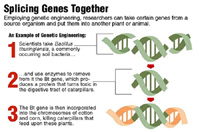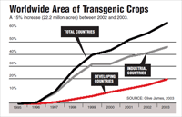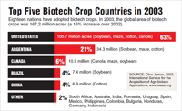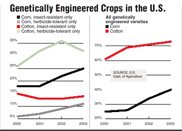Suggested Reading:
 Tomorrow’s Wonderful World – An Inside View!
Tomorrow’s Wonderful World – An Inside View!
As part of the continuing quest to “out-do” God, man has tampered with the very core of our food supply. What are the implications of this trend?
Subscribe to the Real Truth for FREE news and analysis.
Subscribe NowFor at least the last decade, unbeknownst to many, human beings have been eating foods created in laboratories. This is a completely new phenomenon, with no long-term studies having been conducted as to the effects of such food. The human race—serving as guinea pigs—is part of the largest uncontrolled experiment ever undertaken!
Today, about two-thirds of all food available in supermarkets has been genetically engineered. Government agencies have long assured the public that these new “biotech” foods present no threat to human health or the environment. Only now are many realizing the extent to which they have been misled and the ominous consequences of this genetic intrusion.
Plants and animals consist of millions of cells. Every cell has a nucleus, and inside each nucleus are strings of DNA. As the building block of life, DNA contains the needed information for the structure and function of any particular organism. Comprised of distinct sequences in the DNA chain, genes represent the blueprint of any given organism. All the characteristics of living organisms—whether plant, micro-organism, animal or human—are determined by the information stored in these genes.
 North Carolina State University, College of Agriculture and Life Sciences
North Carolina State University, College of Agriculture and Life Sciences
Genetic engineering (GE) is the practice of altering that genetic blueprint, to create “genetically altered” (GA) or “genetically modified” (GM) foods, or “genetically modified organisms” (GMOs). Through genetic engineering, scientists can impart desired genetic characteristics by splicing genetic segments of one species into the genes of another. This could never occur naturally. Consider one example: Certain genes from a flounder—a fish—have been inserted into tomatoes in order to give them a longer shelf life.
Biotech corporations, which develop and market genetically engineered crops, promote their products as ideal solutions to nutrition, world hunger and the environment.
Yet, biotech foods are looked upon with suspicion by most of the world. Only in the U.S. has the biotech pitch been so blindly accepted, as two-thirds of all food consumed here are already genetically engineered. But even this has been done without public awareness.
The following summarized issues below show how some of the claims presented by biotech promoters fall far short of reality.
These summaries present a cross-section showing how the facts have been suppressed—especially in the U.S.
Scientists claim that their genetically altered crops are nutritionally superior to naturally occurring crops. For example, the promoters of “golden rice” touted it to be superior to natural rice in vitamin A and other nutrients. Extensive testing later revealed this rice to be inferior to natural rice. The well-documented book, Genetically Engineered Foods: Are They Safe? You Decide, exposes the façade given to “golden rice” and other biotech foods. It presents ample proof that GE foods are missing vitally important nutrients.
This and related books shed light on biotech claims that their innovations are safe—being no different than the traditional hybridization and crossbreeding practiced over time. However, traditional means of growing crops and breeding animals never violate the natural boundaries of different species.
With the newly developed GE crops and animal species, ominous dangers now exist that were never a factor when working within natural boundaries.
The developers of GE foods also claim that mutated foods are the answer to the dilemma of world hunger. It is interesting that one of the largest biotech companies has developed the “terminator seed,” in which the seeds produced are sterile. Farmers using this seed would have to purchase their seed annually instead of saving it from previous crops. If such crops were to become universal, as its promoters hope, then 1.4 billion farming families (mostly in third world countries, producing up to 20% of the world's food supply) would be at the mercy of these biotech companies. Far from seeking a solution to world hunger, it would seem that these companies would hold the world's poorest farmers hostage, in the interest of greater profits. Fortunately, the vast majority of third-world nations have flatly rejected the use of terminator seeds.
Assuming the biotech industry sincerely hopes to help feed the world, does it have the capacity? The promoters of GE crops claim their crops can produce much higher yields than what normally occurs. Researchers have repeatedly proven biotech claims as false. Genetically engineered seeds do not significantly increase crop yield. In one study by the Board of Agriculture of the National Academy of Scientists, of more than 8,200 field trials, GE soybeans produced fewer bushels of soybeans than those grown from natural seeds.
The claim that GE crops actually require less pesticide has not been proven through practice. In fact, new GE crops can withstand increased amounts of pesticides—the very pesticides the biotech companies seek to sell!
Biotech promoters claim that their newly developed crops will help preserve the environment. Ironically, the very companies that developed and promoted DDT and Agent Orange are once again assuring us that their latest innovations—GE crops—are environment-friendly. Farmers in the U.S. have planted over 90 million acres of GE crops for 5 years, constituting one-fourth of total available farmland.
Already, some unexpected surprises have surfaced. In the spring of 1999, scientists at Cornell University discovered that pollen from mutated corn settled on the leaves of milkweed plants, from which the Monarch butterfly larvae feed. The larvae died in just four days. As a result, about half of the Monarch butterfly population has already died out—threatening its extinction. If the delicate Monarch is the first to die, what will be next?
Where will the cycle end?
As the mutated GE crops cross-pollinate with other crops in their region, greater dangers will result. This is already beginning to occur. One example is that GE crops—mutated to resist pesticide—cross-pollinate with weeds, causing the rise of pesticide-resistant “superweeds.” Even worse, imagine the implications of the sterilization of natural crops from pollination by “terminator seed” crops.
Mutated Atlantic salmon, developed on biotech fish farms, grow to maturity four times faster than normal. An environmental nightmare would result if any of the mutated fish escaped into the wild and bred with their original species. This would devastate fish populations, because the available food supply could not sustain these fish.
Genetic engineers have also introduced new versions of potatoes that produce their own pesticides. Most of the potatoes sold in U.S. supermarkets are these mutated potatoes. This potato was given the go-ahead by governmental agencies, quietly bypassing the testing and approval procedures normally required. It is called the New Leaf Superior and produces it own insecticide, Bt (Bacillus thuringiensis), which is naturally produced in certain plants—but never in potatoes. Bt is used to kill the Colorado potato beetle—a real and dangerous threat to potato farmers.

Unfortunately, as has been the case with all other GE foods, these pesticidal potatoes are not labeled. Unless you purchase organic potatoes, there is no way to insure that you are not consuming these pesticidal potatoes. And the long-term effects of ingesting significant amounts of Bt are simply not known.
Besides this novel potato, GE scientists at Edinburgh, Scotland have mixed jellyfish genes with potatoes, resulting in potatoes that glow in the dark when they need watering! Although not intended for human consumption (used only for water monitoring purposes), some ecologists fear that such potatoes could easily become mixed with other potatoes.
Government agencies, established to function in the public interest, have opted instead to function in the interest of the biotech industry. When questioned about the pesticidal potato, the director of corporate communications for a large biotech corporation told the New York Times that “Monsanto should not have to vouchsafe the safety of biotech food. Our interest is selling as much of it as possible. Assuring its safety is the FDA's job” (Seeds of Deception: Exposing Industry and Government Lies About the Safety of the Genetically Engineered Foods You're Eating).
The only way to completely avoid GE foods is to buy or grow your own organic food—literally. The first large-scale commercial harvest of GE crops was in 1996. As of 1999, over a fourth of all crops grown in the U.S. were the GE variety. By now, most of the commercially-grown potatoes, tomatoes and various other vegetables are genetically engineered.

Soybeans, corn and their derivatives account for most GE foods. Currently, over half of all soybeans and corn grown in the U.S. are genetically engineered. The following processed foods are now almost entirely genetically engineered: Tortilla chips (except Frito-Lay), taco shells, veggie burgers, muffin mixes and baby formulas. The following soybean or corn derivatives are also primarily the GE variety: Soy oil, soy flour, lecithin, soy protein, corn oil, corn starch, corn flour and corn syrup. (Gerber and Heinz both indicated that they would no longer use GE products in any of their baby foods.)
Since the bulk of soybeans and corn are fed to farm animals, GE mutated organisms find their way into meat, poultry and dairy products. As a side note, there is also concern about dairy products from cows treated with the bovine growth hormone (rBGH)—another biotech product.
Genetic engineering is a young—and poorly understood—technology. While American agencies have turned a blind eye to possible dangers, the Royal Society of Canada stated that the potential allergic effects and toxicity of GE foods could pose serious risks to human health. European agencies agree with this position and most GE foods have been removed from supermarket shelves there.
In 1996, scientists discovered that mutated soybeans contained genes from the Brazil nut, and also contained the same allergic properties of that nut—something the developers never anticipated. Scientists have also discovered that Bt insecticide-producing potatoes, corn and cotton have produced allergies in people—especially farm workers. Science News reported that Ohio crop pickers and handlers in July of 1999 developed allergies due to exposure to Bt—in this case, asthma and other serious allergic reactions.

Most readers will remember the incident in 1989, when a genetically engineered version of the supplement tryptophan produced toxic contaminants. By the time the mutated tryptophan was isolated and recalled, 37 people had died, another 1,500 were permanently disabled, and 5,000 became ill with a serious blood disorder. Yet, the biotech agenda presses on without regrets or hesitation.
The journal Microbial Ecology in Health and Disease reported in 1998 that commercial gene technology may be behind the recent resurgence of drug- and antibiotic-resistant infectious diseases.
The report stated, “At the heart of the issue is horizontal gene transfer—the transfer of genes by vectors such as viruses and other infectious agents—which is exploited by genetic engineers to make transgenic organisms. While natural vectors respect species barriers, the barrage of artificial vectors made by genetic engineers are designed to cross species barriers, thus greatly enhancing the potential for creating new viral and bacterial pathogens, and spreading drug and antibiotic resistance. Totally unrelated pathogens are showing up with identical virulence and antibiotic resistance genes.
“Recent statistics are frightening. Infectious diseases were responsible for one-third of the 52 million deaths from all causes in 1995. Multi-drug resistant tuberculosis is now estimated to affect 10 million each year with 3 million deaths. At least 50 new viruses attacking humans emerged between 1988 and 1996. Between 1986 and 1996, E. coli 0157:H7 infections increased 10-fold in England and Wales and 100-fold in Scotland. Vancomycin resistance rose from 3 percent to 95 percent in San Francisco hospitals in the four years between 1993 and 1997. And Staphyloccocus is now invulnerable to all known antibiotics.
“The first genetic engineers called for a moratorium in the Asilomar Declaration of 1975, precisely because they were afraid of inadvertently creating new viral and bacterial pathogens. The worst case scenario they envisaged may be taking shape. Commercial pressures led to regulatory guidelines based largely on untested assumptions, all of which have been invalidated by recent scientific findings. For example, biologically “crippled” laboratory strains of bacteria can often survive in the environment to exchange genes with other organisms...We may only be seeing the tip of the iceberg...”
In spite of mankind's defilement of the creation, there remains one source of hope for the restoration of the entire ecosystem. This calls upon the existence of a Creator who is able and determined to restore the purity of air, water, soil and even the integrity of plant and animal life as it once existed.
At the creation of man 6,000 years ago, God created certain herbs and plants for food (Gen. 1:12, 29). Ever since, mankind has tried to improve on God's perfect creation—and in every case has failed!
At the outset of the millennial reign of Christ on earth, the waters and land will have to be miraculously healed and purified from the abuse and arrogance of mankind. Ezekiel 47:8-12 describes part of this process, in which the waters, fish, other aquatic life, the flora and fauna, and the land itself will be restored to the purity that God intended. Nothing short of the miraculous power of God will be able to restore the otherwise irreversible damage caused by mankind's destruction of the earth and all life upon it.
A new world order truly awaits those who live to experience the millennial reign of Christ on this earth. As the ecosystem is being healed, a rebuilding program will begin, as the earth emerges from its state of ruins and ashes. A new civilization will be formed, from the ground up.
Under the new government, with the glorified Christ at the helm, the population of the earth (though no more than a tenth of the present population) will be given new purpose in life. Urban congestion will no longer exist, as the vast majority of people are spread out in an agrarian lifestyle.
At that time, every family will grow a sizable portion of their own food on their own land, in an atmosphere of peace and tranquility: “But they shall sit every man under his vine and under his fig tree; and none shall make them afraid: for the mouth of the Lord of hosts has spoken it” (Micah 4:4). You can learn much more about this incredible good news just ahead by reading our book Tomorrow’s Wonderful World – An Inside View!